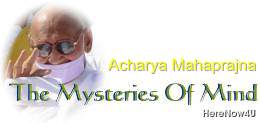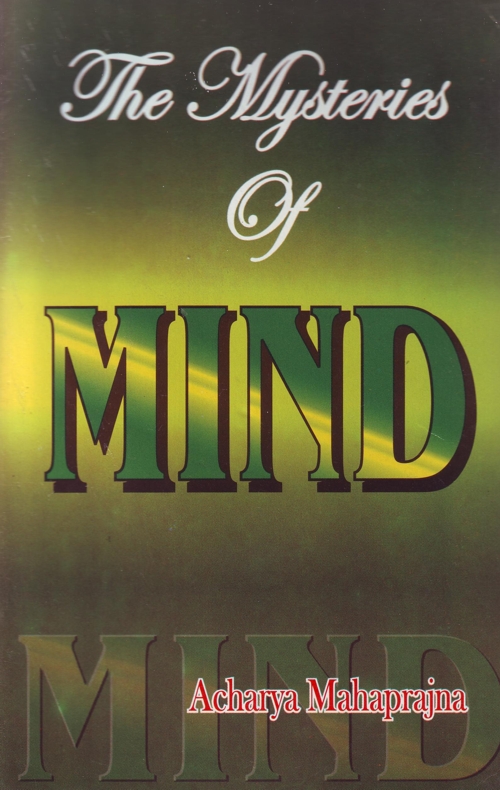
Kayotsarga can be achieved in two stages. The first is complete relaxation of the body and the other is its stabilization and abandonment. Realization is not abandonment. Abandonment of the body means a clear experience of the separation of the body from consciousness. In such an experience one comes to feel that the body and consciousness stand apart and are quite distinct from each other. In figurative language it means that the bird, which had been engaged, has flown away into the open sky leaving behind the cage. This happens when the mind has become completely immersed in the self. Then the hands and feet, the sense organs and speech become fully restrained.
The process of the abandonment of the body is a two-way process. It is an internal as well as an external process. Firstly, we have to restrain the hands and feet, the sense organs and speech. Secondly, we have to sit in such a physical posture, which will divert the flow of the mind and vital energy towards the self. If the mind could be inverted and made to catch glimpse of our real existence, every particle of the body will become calm. There will be no need for further effort. The fickleness of the body will automatically disappear and the soul will manifest itself in a manner in which it had never done before. The practitioner's personality will become completely integrated. There has been a lot of talk about such an integration of personality but few have actually experienced it.
There are some who believe in the existence of the soul. There are others who deny it. Mere belief in the existence of the soul cannot be logically justified. Its existence so far as it is a matter of belief can be easily disproved. We believe that the soul exists because we have been told that it does. Belief is not knowledge. Direct knowledge of the soul is a matter of personal experience, which can be had in a state of kayotsarga, which is a door through which we can enter into the soul directly. Once we get a direct glimpse of the soul, kayotsarga becomes achieved of its own accord. Spiritual experience means experience of our real existence, of pure consciousness and of that state in which the soul remains a pure spectator and knower.
We perceive and know things but our perceptions and knowledge are not perfect. Curd mixed with sugar is neither pure curd nor pure sugar. Its taste is neither that of pure curd nor that of pure sugar. It is quite different from both. Consciousness is also in the same plight. We are neither able to perceive pudgala or matter nor consciousness exclusively. Our empirical experience consists of a combination of both. We have accepted empirical experience to be valuable and cling to it. If we could perchance get a glimpse of pure consciousness, we will find it to be incomparable and will never like to discard such an experience. It will madden us. We would be prepared to make the greatest sacrifice to retain it. We would take it to be all in all. That is the way in which spiritual experience works. But the path, which leads to the experience of the self, is a thorny path beset with great difficulties. The distance we have to cover is no doubt a short distance, but we will have to do a lot of struggle to traverse it. Moreover, it is a winding path. While walking on this path we will have to activate the faculty of discernment. It is here that we become conscious of the value of pratyakhyana or renunciation and of the distinction between what is desirable and what is not. It is again here that we get a glimpse of our real existence. It is here that we enter into the process of renunciation. It is true that what we try to relinquish is not ready to relinquish us. Renunciation or pratyakhyana and discernment do not mean merely giving up things. Discernment does not become operative unless both the desirable and the undesirable are actually present before us. Discernment chooses that which is desirable without which pratyakhyana is meaningless. Once the choice has been made, that which is desirable begins to exercise a pressure on us and that which is undesirable begins to disappear without any effort on our part to discard it. The spirit of renunciation becomes active of its own accord. Man will become a dead entity if this choice is not offered to him. Only a moral choice is a step in the direction of self-realization. Renunciation is not a negative attitude. It is a rational process of abandonment. It is through reason that mankind has preferred the railways to the bullock carts and the aeroplanes to the railways. It is natural for man to choose what is progressive in place of what is retrogressive. Reason is a natural property of man.
The spirit of renunciation reveals to us the value of moral discipline and attracts us towards it. The practitioner prefers to live in the world of the spirit and becomes immersed in it. The glow of consciousness becomes so attractive to him that he does not like to revert to the darkness of the empirical World. But a glimpse of this new horizon brings about a fierce struggle in the mind of the practitioner. The influx of alien matter in the soul, natural tendencies and emotions begin to resist the expansion of consciousness. Attachments and aversions begin to cast their ominous shadow on the mind of the practitioner. Self-negligence and passion for material objects take up arms to resist the new development. Inertia becomes entrenched against it. A fierce battle ensues within the practitioner. This battle provides great opportunities for him and he must take his chance. The Acaranga says: 'The opportunity for this struggle is a god-sent boon and it does not come time and again. It is a rare opportunity." The practitioner can achieve his real existence through this struggle only. He comes to realize that the rehabilitation of the soul as a seer and knower par excellence is much more commendable than the watching of breath and the activation of the centres of consciousness, fasting and moral discipline. He leaves these exercises behind and steps up to a higher level of consciousness. Once he has upgraded himself to this higher level he comes to know that his path is no more winding and thorny. But for those who have not attained this stature, the struggle is a life-and-death struggle. They cannot proceed even a single step forward until they have conquered all the enemies whose combined attack seems to be baffling. This struggle takes place only at an advanced stage of sadhana and not in the beginning when the influx of alien matter in the soul and man's natural tendencies are not so hard-pressed as to offer fierce resistance. Their resistance increases in intensity with the advancement of sadhana and in the face of the practitioner's determined assault on their lines of defence. They counterattack like an enraged cobra terribly hissing and striking when cornered. They will behave in their normal way and peacefully if they are not challenged. But once the practitioner has challenged them with the intention to uproot them from their base, which they have been rooted in for centuries in the past, they become fierce. It is at this juncture that the practitioner is in dire need of a guide or guru. If he does not get a guru, he is likely to lose heart and withdraw from the battle. The practitioner has to exercise great restraint and patience at this middle stage of sadhana.
 Acharya Mahaprajna
Acharya Mahaprajna

